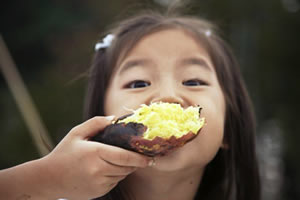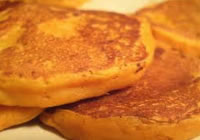News and Notes from The Johnson Center
Sweet Potatoes and Yams: Facts, Tips and How to Get Kids Eating Them
JCCHD | Wed, March 27, 2013 | [Family and Food]
What is a Yam? And What is a Sweet Potato?
Most people in the United States think that they have eaten a yam at some point in their lives, but more often than not it was actually a sweet potato. Blame the U.S. Department of Agriculture. People continue to frequently mistake sweet potatoes for yams. This blunder can be traced back to the colonial times. Initially, there were only firm varieties of sweet potatoes, and it was necessary to differentiate them from the new variety of soft sweet potatoes. Sweet potato pickers in the US were already calling them yams (an African word meaning “to eat”) since it resembled the yams back home in Africa. The name stuck and is still used on many food labels. A decade ago, to find a true yam, you had to go to an international market. Today, true yams as well as sweet potatoes are more and more available in local markets across the country. (1)
What are the main differences in these tubers? Truthfully, the differences are quite subtle. Both vegetables vary in size and color. However, sweet potatoes are generally smaller than yams and taper off at the ends. Sweet potatoes also have a firm variety, which stays firm after cooked whereas yams will always soften. Yams also tend to be drier and starchier than sweet potatoes. (2)
Ought I to be pursuing yams instead of sweet potatoes?
Sweet potatoes and yams taste good and are good for you. Below is a short list of a few health benefits.
• The tubers contain almost 7 grams of fiber per serving. This combination of carbohydrates and fiber slows down the use of caloric energy making it a more efficient use of calories. This also benefits the impact of carbohydrate intake on blood sugar levels, making blood sugar more stable over time. 3
• Sweet potatoes and yams are heart healthy. They consist of a large amount of vitamin B6, which breaks down a substance that hardens the arteries and blood vessels. As result, the blood pathways remain flexible and healthy. (3)
• They are rich in beta-carotene. Beta-carotene is the most potent antioxidant. It helps prevent several different types of cancer. (4)
How to Pick and Store
Like most produce, do not select sweet potatoes or yams that have cracks, bruises, or soft spots. Pick the firm ones. Additionally, they are sensitive to light and heat (which makes sense since they are grown underground). They can last up to ten days in cool, dark, ventilated environments. You should store in a brown bag with holes for ventilation (preferably in a cupboard, pantry, or closet). Likewise, avoid buying sweet potatoes or yams from the refrigerated section in the grocery store. The cold temperatures negatively affect flavor and diminish the quality of the root. (5)
Tips for Preparing
Sweet potatoes and yams oxidize like avocados. Cook them as soon as they are cut, because the flesh will darken quickly. If immediate cooking is not an option, you can keep them in a bowl completely submerged in water to stop the oxidation process.
Peeling is optional but recommended if you are not buying organic. Conventionally grown sweet potatoes and yams may have dyes, waxes, pesticides, and preservatives on the skin. (5)
Getting Kids – even Picky Eaters - to Eat Them
Picky eaters often stick to the same types of foods. Identifying the kind a food a child likes will help to “trick” them into liking a new food. The trick is to find out how to add to their repertoire of foods without calling a lot of attention to it. For most kids, they like a particular flavor or texture. Sweet potatoes and yams are great for the child with a sweet tooth who likes smoother textures because they are, well… sweet. They can make great pancakes, muffins, cookies, and even oatmeal. Sweet potatoes can also be pureed or fried for those who enjoy mushy or crispy foods.
Below you will find a sweet potato pancake recipe and a maple sweet potato recipe (both taken from The Kid-Friendly ADHD & Autism Cookbook) that are sure to please even the pickiest of eaters.
Sweet Potato Pancakes
Yields 16

Ingredients
• 1 lb sweet potatoes peeled
• ½ cup brown rice flour (or any GF flour)
• 2 tsp sugar (or Succanat)
• 1 tsp brown sugar
• 1 tsp baking powder
• 1 tsp cinnamon
• ⅛ tsp cayenne (optional)
• 1 tsp curry powder
• ½ tsp cumin
• Salt & pepper to taste
• 2 large eggs beaten
• ½ cup milk substitute
• 1 large onion diced
• Oil for frying
Instructions
1. Grate sweet potatoes coarsely.
2. In a separate bowl mix all dry ingredients.
3. Add eggs and just enough milk substitute to make a stiff batter.
4. Add potatoes and onion to the mix. Batter should be moist but not runny. If too stiff, add more milk substitute.
5. Heat ¼ inch of oil in a frying pan until smoking.
6. Drop batter by tablespoon onto the frying pan and flattened.
7. Fry over medium - high heat until golden brown on each side.
8. Drain on paper towel then serve.
Maple Mashed Sweet Potatoes
Ingredients
• 2 lbs. sweet potatoes
• ¼ cup maple syrup
• 2 Tbsp. ghee
• ½ tsp. ground nutmeg
• Salt and pepper to taste
Instructions
1. Peel and cut potatoes into large chunks.
2. Place in a large bowl with 1 tsp. salt, cover with cold water, and bring to boil.
3. Reduce heat and simmer for 15 to 20 minutes, until tender.
4. Drain and return to pot.
5. Add the remaining ingredients, season with salt and pepper, and mash with a potato masher or fork.
6. Serve.
Printable recipe
Article Reference
1 http://www.huffingtonpost.com/2012/11/19/difference-between-sweet-potatoes-and-yams_n_1097840.html
2 http://www.loc.gov/rr/scitech/mysteries/sweetpotato.html
3 http://www.naturalnews.com/035739_sweet_potatoes_beta-carotene_nutrients.html
4 http://www.nlm.nih.gov/medlineplus/druginfo/natural/999.html
5 http://www.whfoods.com/genpage.php?tname=foodspice&dbid=64



